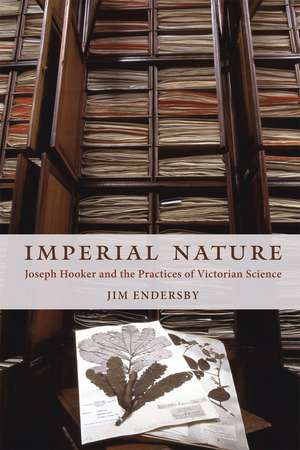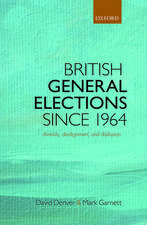Imperial Nature: Joseph Hooker and the Practices of Victorian Science
Autor Jim Endersbyen Limba Engleză Paperback – 23 sep 2010
Joseph Dalton Hooker (1817–1911) was an internationally renowned botanist, a close friend and early supporter of Charles Darwin, and one of the first—and most successful—British men of science to become a full-time professional. He was also, Jim Endersby argues, the perfect embodiment of Victorian science. A vivid picture of the complex interrelationships of scientific work and scientific ideas, Imperial Nature gracefully uses one individual’s career to illustrate the changing world of science in the Victorian era.
By analyzing Hooker’s career, Endersby offers vivid insights into the everyday activities of nineteenth-century naturalists, considering matters as diverse as botanical illustration and microscopy, classification, and specimen transportation and storage, to reveal what they actually did, how they earned a living, and what drove their scientific theories. What emerges is a rare glimpse of Victorian scientific practices in action. By focusing on science’s material practices and one of its foremost practitioners, Endersby ably links concerns about empire, professionalism, and philosophical practices to the forging of a nineteenth-century scientific identity.
By analyzing Hooker’s career, Endersby offers vivid insights into the everyday activities of nineteenth-century naturalists, considering matters as diverse as botanical illustration and microscopy, classification, and specimen transportation and storage, to reveal what they actually did, how they earned a living, and what drove their scientific theories. What emerges is a rare glimpse of Victorian scientific practices in action. By focusing on science’s material practices and one of its foremost practitioners, Endersby ably links concerns about empire, professionalism, and philosophical practices to the forging of a nineteenth-century scientific identity.
Preț: 283.30 lei
Nou
Puncte Express: 425
Preț estimativ în valută:
54.23€ • 58.92$ • 45.58£
54.23€ • 58.92$ • 45.58£
Carte tipărită la comandă
Livrare economică 21 aprilie-05 mai
Preluare comenzi: 021 569.72.76
Specificații
ISBN-13: 9780226207926
ISBN-10: 0226207927
Pagini: 448
Ilustrații: 50 halftones
Dimensiuni: 152 x 229 x 25 mm
Greutate: 0.59 kg
Editura: University of Chicago Press
Colecția University of Chicago Press
ISBN-10: 0226207927
Pagini: 448
Ilustrații: 50 halftones
Dimensiuni: 152 x 229 x 25 mm
Greutate: 0.59 kg
Editura: University of Chicago Press
Colecția University of Chicago Press
Notă biografică
Jim Endersby is a lecturer in the history department at the University of Sussex.
Cuprins
List of Illustrations
Acknowledgements
Introduction
1. Traveling
2. Collecting
3. Corresponding
4. Seeing
5. Classifying
6. Settling
7. Publishing
8. Charting
9. Associating
10. Governing
Conclusion
Notes
Bibliography
Index
Acknowledgements
Introduction
1. Traveling
2. Collecting
3. Corresponding
4. Seeing
5. Classifying
6. Settling
7. Publishing
8. Charting
9. Associating
10. Governing
Conclusion
Notes
Bibliography
Index











